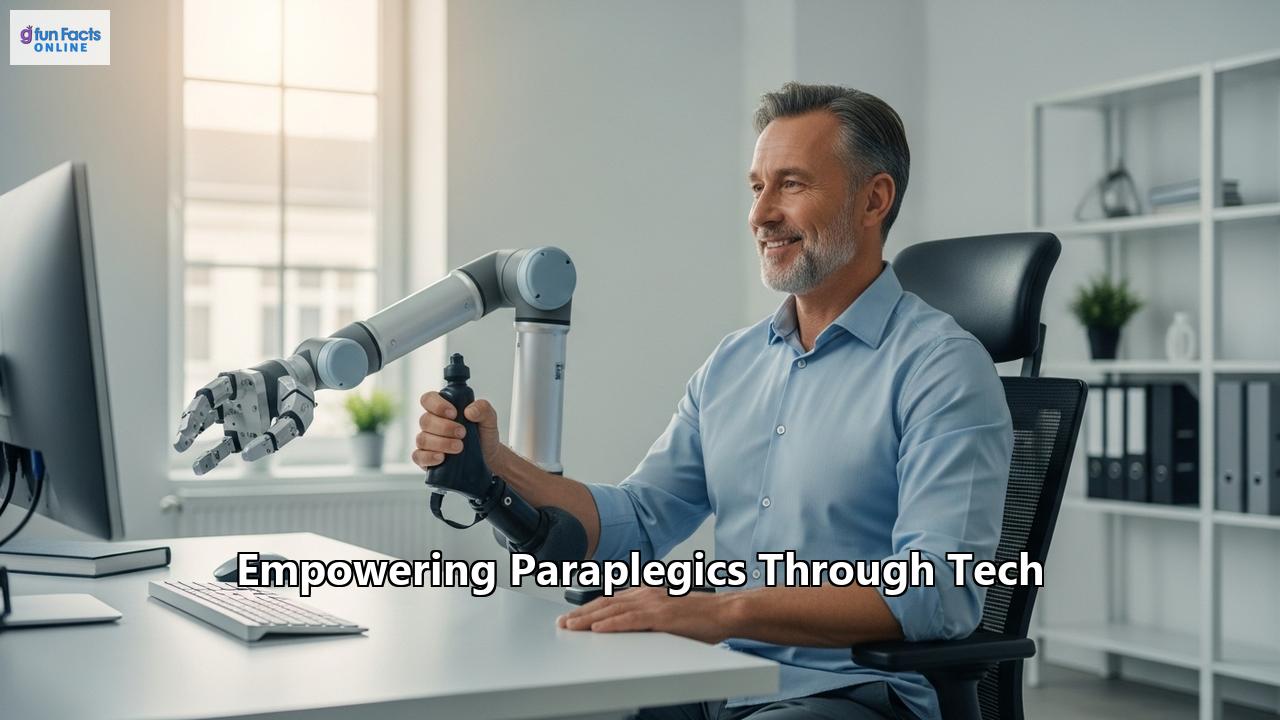For individuals living with paraplegia, the boundaries of what is possible are continually being redefined, thanks to a wave of technological innovation. From regaining the ability to walk to controlling a digital world with just a thought, technology is not just assisting—it's empowering. This article delves into the latest and most exciting advancements that are revolutionizing lives, restoring independence, and offering a brighter future.
The Dawn of a New Era: Restoring Mobility
The dream of walking again is becoming a reality for many with spinal cord injuries, thanks to groundbreaking developments in exoskeletons and spinal cord stimulation.
Robotic Exoskeletons: A New Lease on LifeWearable robotic exoskeletons are mechanical suits that provide powered assistance to the hips and knees, enabling individuals with paraplegia to stand, walk, and even navigate stairs. These devices, which have been in development since the late 1960s and early 70s, are now more sophisticated than ever. Companies like ReWalk Robotics and Ekso Bionics are at the forefront, with products like the ReWalk Personal Exoskeleton, which is designed for everyday use at home and in the community.
These exoskeletons not only offer the physical benefit of mobility but also the profound psychological impact of being able to interact with the world at eye level. Lin Han, a 34-year-old who has been paraplegic for nearly a decade, found a new lease on life with an exoskeleton. He now takes hour-long walks daily, which helps prevent muscle atrophy and has improved his overall strength. Beyond walking, some exoskeletons are being designed to allow users to walk hands-free, and there are even models specifically for children with neuromuscular diseases.
While the technology is still maturing and is not yet a complete replacement for a wheelchair, the potential to alleviate health problems associated with prolonged wheelchair use, such as shoulder overuse and osteoporosis, is significant. Competitions like the CYBATHLON are pushing the boundaries of exoskeleton technology, with challenges that test balance and dynamic movements without the use of crutches.
Spinal Cord Stimulation: Reawakening the NervesA revolutionary approach to restoring movement involves stimulating the spinal cord with electrical impulses. This can be done non-invasively or through tiny implants. The ARC-EX device, for example, uses an electrical current to stimulate the spinal cord through the skin, enhancing strength and sensation. A study involving this device showed that 90% of participants experienced meaningful improvements in strength or function.
More invasive but incredibly promising are implantable devices that create a "neural bypass." In a remarkable clinical trial in Shanghai, four paralyzed patients regained control of their legs within 24 hours of a minimally invasive surgery where electrode chips were implanted in their brain and spinal cord. This "brain-spinal interface" reignites dormant nerves, potentially leading to a rewiring of the nervous system that could free patients from the devices altogether.
The Power of the Mind: Brain-Computer Interfaces
Brain-Computer Interfaces (BCIs) are a frontier of neurotechnology that are changing the way individuals with paralysis interact with the world. By capturing and translating brainwave activity into digital commands, BCIs allow users to control computers, prosthetic limbs, and other devices with their thoughts.
Restoring Communication and ControlRecent advancements in BCIs have been astounding. In one study, a BCI was developed that could continuously decode three independent finger groups, allowing a person with tetraplegia to play a video game. This level of precision opens up possibilities for tasks like typing and playing musical instruments.
BCIs are also being combined with other technologies to restore movement. ONWARD Medical has successfully implanted its ARC-BCI® Therapy in five individuals with spinal cord injuries, allowing them to potentially control movement through thought. This system creates a wireless "DigitalBridge™" between the brain and spinal cord, using AI to decode neural signals and translate intention into movement.
Researchers are also developing non-invasive BCIs that use EEG caps to detect movement intentions. This technology could cue spinal cord stimulation to aid in rehabilitation, offering a less invasive path to restoring voluntary movement.
A Smarter Home, A More Independent Life
Smart home technology is transforming daily life for people with paralysis by providing greater control over their environment. Voice-activated assistants like Amazon Alexa and Google Home, connected to smart plugs, lights, and thermostats, allow individuals to manage their homes with simple commands. This can be a game-changer for those with limited mobility, fostering a greater sense of independence.
Smart locks can eliminate the struggle with keys, and wireless remote-controlled outlets can make it easy to power devices on and off. Some organizations are even creating "SmartTech Implementation Hubs" to research and promote the use of these technologies for individuals with paralysis, aiming to improve independence and reduce caregiver burden.
Redefining Recreation: The World of Adaptive Sports
Technology is also breaking down barriers in the world of sports. The Paralympic Games showcase a stunning array of assistive technologies, from high-performance racing wheelchairs to advanced prosthetics. Wheelchairs for sports are now lighter and more maneuverable than ever, thanks to materials like aluminum and titanium.
For those seeking adventure, adaptive sports equipment like the "Spike" allows individuals with lower body disabilities to traverse various terrains, from city roads to forest trails. There are also a growing number of adaptive sports leagues for activities like wheelchair boxing and wheelchair cricket, providing more opportunities for recreation and competition.
The Future is Now
The pace of innovation in assistive technology is accelerating, with new breakthroughs emerging regularly. From AI-powered smart glasses and self-driving wheelchairs to wearable haptic feedback devices, the future promises even greater independence and quality of life for individuals with paraplegia. As research continues to push the boundaries of what's possible, the fusion of human resilience and technological ingenuity is creating a world where paralysis is no longer a barrier to a full and engaging life.
Reference:
- https://golifeward.com/products/rewalkpersonal-exoskeleton/
- https://cybathlon.com/en/event/disciplines/exo
- https://english.news.cn/20230329/2498b4f547c04cfdb2ba1e84cd12a5e0/c.html
- https://medicalfuturist.com/exoskeleton-technology/
- https://techround.co.uk/startups/tech-startups-paraplegics-independence/
- https://www.scmp.com/news/china/science/article/3301416/chinas-neurotechnology-breakthrough-challenges-elon-musks-verdict-paralysed-patients
- https://national-claims.co.uk/5-life-changing-technologies-for-spinal-cord-injuries-from-paralysis-to-progress/
- https://www.news-medical.net/news/20250120/Brain-implant-decodes-finger-movements-in-paralysis-patient-enabling-video-game-play.aspx
- https://trial.medpath.com/news/690bff853bfb1f50/onward-medical-advances-brain-computer-interface-technology-with-fifth-successful-implant-for-spinal-cord-injury-patients
- https://neurosciencenews.com/sci-brain-spine-interface-28761/
- https://www.ijrar.org/papers/IJRAR23B1274.pdf
- https://home.myodp.org/2025/01/27/smart-homes-empowering-people-with-disabilities/
- https://craighospital.org/inpatient/assistive-technology/smart-home-technology
- https://www.pittwire.pitt.edu/pittwire/features-articles/donation-forms-smarttech-implementation-hub-paralysis-care
- https://paralympics.org.nz/news/the-role-of-technology-in-the-paralympics-advancing-abilities-and-experiences/
- https://orthopus.com/parasport-assistive-technologies/
- https://smartgroup.no/en/spike/
- https://www.spinalcord.com/blog/unique-adaptive-sport-options-for-paraplegics
- https://thinkbeyondthechair.org/the-best-assistive-tech-gadgets-in-2025-enhancing-independence-through-innovation/

